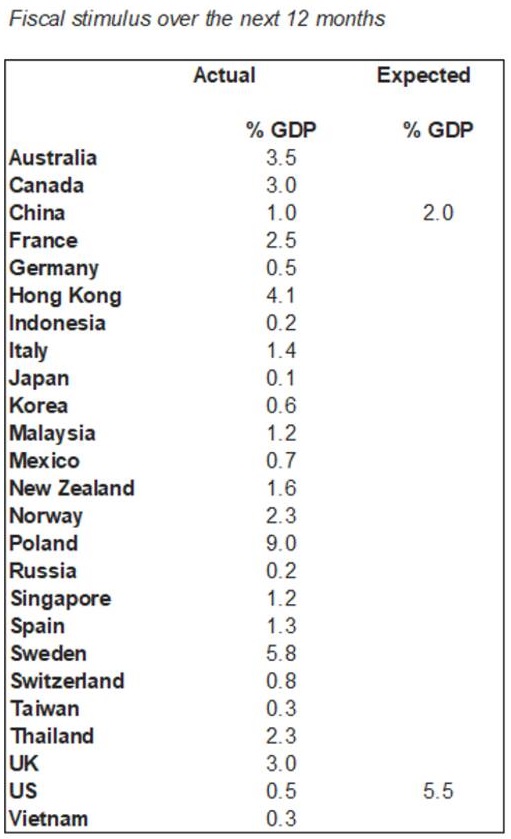
Over the weekend in Australia, the federal government announced a second fiscal stimulus package to offset the hit to growth from COVID-19.
Below are some of the main take-aways:
-
An additional $46bn worth of direct government spending for individuals and businesses impacted the coronavirus.
Along with the first round of stimulus announced recently ($17.6bn to individuals and businesses, $2.4bn to the healthcare sector and $5bn of stimulus by the states) total Australia fiscal stimulus in response to coronavirus is worth around 3.5% of GDP.
This is in-line with other countries who have recently announced fiscal packages (see the table below). Most of the stimulus in Australia is front-end loaded over the next year.

Source: UBS, Bloomberg, AMP Capital
-
Other stimulus measures include cheap bank financing which is aimed to stimulate borrowing, part of this was announced by the Reserve Bank of Australia last week.
The government also announced a $20bn loan guarantee to help impacted small/medium-sized businesses meet cash flow requirements. If you include these total loan guarantees with the direct fiscal stimulus then total stimulus in the economy is worth around 10% of GDP.
Then there are also the RBA interest rate cuts and three-year government bond purchases to meet the 0.25% yield target. So there is a lot of stimulus being thrown around in Australia which is completely necessary at the moment.
-
Details of the package announced yesterday also include: increase the payment of the Newstart allowance (an additional $550/fortnight) and expanded eligibility for income support (the Newstart allowance). It also includes a further $750 payment (on top of the $750 already announced) for those on welfare support (5.2 million Australians), early access to superannuation for those whose wages have been directly affected by the virus (draw up to $10K from superannuation this and next financial year) tax-free, more flexibility around retirees on drawing down on their superannuation and increasing cash payments to SMEs ($20K payment up to $100K).
-
Total global stimulus to combat the economic risks from the coronavirus should equal around 2% of GDP (including measures that we expect to be announced from the US and China). This is more than during the GFC (see the chart below) as countries deal with the most disruptive global shock since WWII.

Source: UBS, Bloomberg, AMP Capital
-
The PM said that more stimulus is likely, expect more direct cash handouts to Australian households more broadly to be announced over the next few weeks.
-
Increased government spending stimulus alongside the hit to economic growth means that Australian AAA credit rating by international ratings agencies will be at risk of being downgraded. But the rest of the world is (relatively) in the same boat as governments will stretch budgets to support the economy. In theory, a downgrade to the sovereign AAA credit rating will increase Australian bond yields and the cost of borrowing for the government. However, the evidence on this isn’t conclusive. The US downgrade in 2011 saw bond yields fall after its credit rating was downgraded.
-
As we have said before we don’t think that fiscal stimulus will be enough to keep Australia out of recession over March/June quarter. The hit to GDP growth in the March quarter from lower Chinese tourist and education spending, along with the impact to the bushfires will be large. June quarter GDP growth will be impacted by the rest of world (ex China) dealing with coronavirus shutdowns and we see a Eurozone and US recession occurring this year which will be another negative impact to Australian export growth. On top of that, more local infections of the virus is leading to some lockdowns with more expected which will limit consumer spending. Our base case is now for a 3.5% contraction in the Australian economy but it could be larger.
-
The fiscal stimulus package will help in limiting the depth of the Australian recession, it will help to keep companies afloat (and should provide some limit for keeping the unemployment rate from skyrocketing) and it is necessary to get a strong recovery after the virus has run its course. It is important to keep tracking how the daily change in new coronavirus infections is tracking globally (see the chart below), especially compared to the China experience. Unfortunately there are no signs yet of EU/US infections reaching a peak as lockdowns have only been imposed for a short time.
By Diana Mousina
Economist – Investment Strategy & Dynamic Markets
Source: AMP Capital 23 March 2020
Important notes: While every care has been taken in the preparation of this article, AMP Capital Investors Limited (ABN 59 001 777 591, AFSL 232497) and AMP Capital Funds Management Limited (ABN 15 159 557 721, AFSL 426455) (AMP Capital) makes no representations or warranties as to the accuracy or completeness of any statement in it including, without limitation, any forecasts. Past performance is not a reliable indicator of future performance. This article has been prepared for the purpose of providing general information, without taking account of any particular investor’s objectives, financial situation or needs. An investor should, before making any investment decisions, consider the appropriateness of the information in this article, and seek professional advice, having regard to the investor’s objectives, financial situation and needs. This article is solely for the use of the party to whom it is provided and must not be provided to any other person or entity without the express written consent of AMP Capital.



